Spring Renaissance |
||||||||||||||||||||||
 |
 |
|||||||||||||||||||||
Crocheted jumper in DROPS Sky. The piece is worked top down with round yoke, lace and fan pattern and trumpet sleeves. Sizes S - XXXL.
DROPS 230-37 |
||||||||||||||||||||||
|
------------------------------------------------------- EXPLANATIONS FOR THE PATTERN: ------------------------------------------------------- PATTERN: See diagrams A.1 and A.2. CHAIN STITCH: If you work outermost on the hook the chain stitch will often be too tight; 1 chain stitch should be as long as 1 double/treble crochet is wide. CROCHET INFORMATION: At the beginning of each round of treble crochets, work 3 chain stitches which do not replace the first treble crochet. Finish the round with 1 slip stitch in the 3rd chain stitch at the beginning of the round. At the beginning of each round of double crochets, work 1 chain stitch which does not replace the first double crochet. Finish the round with 1 slip stitch in the first chain stitch at the beginning of the round. INCREASE TIP: Increase 1 stitch by working 2 treble crochets in the same stitch. To work out how to increase evenly, count the number of stitches on the round (e.g. 108 stitches) and divide by the number of increases to be made (e.g. 15 stitches) = 7.2. In this example, increase by working 2 treble crochets in approx. every 7th stitch. DECREASE TIP: Work 2 treble crochets together as follows: * Make 1 yarn over, insert the hook through the next stitch, pick up the strand, make 1 yarn over and pull it through the first 2 loops on the hook *, work from *-* 1 more time, make 1 yarn over and pull it through all 3 loops on the hook (= 1 stitch decreased). CROCHET TIPS: The piece is turned after each round; alternate rounds are worked from the right and wrong side: First round is worked from the right side. Finish with 1 slip stitch in the 3rd chain stitch at the beginning of the round. Turn and work back from the wrong side. Finish with 1 slip stitch in the 3rd chain stitch at the beginning of the round. Turn and work the next round from the right side. Continue back and forth like this, with alternately a round from the right side and a round from the wrong side. ------------------------------------------------------- START THE PIECE HERE: ------------------------------------------------------- JUMPER – SHORT OVERVIEW OF THE PIECE: The neck and yoke are worked in the round, top down. The yoke is divided for the body and sleeves, which are then finished separately in the round. YOKE: Work 104-108-112-116-118-122 CHAIN STITCHES – read description above, with hook size 4 mm and DROPS Sky. Form them into a ring with 1 slip stitch in the first chain stitch worked. Turn – read CROCHET TIP and CROCHET INFORMATION and work as follows: 1 treble crochet in each chain stitch = 104-108-112-116-118-122 stitches. Work 1 round with 1 treble crochet in each stitch and increase 13-15-11-7-17-19 treble crochets evenly spaced – read INCREASE TIP = 117-123-123-123-135-141 stitches. Work A.1 over all stitches and increase as follows: On each 3rd and 5th round in A.1, increase 24-27-33-33-30-33 treble crochets evenly spaced on the round (48-54-66-66-60-66 treble crochets increased during 1 repeat in height). Repeat A.1 onwards. REMEMBER THE CROCHET TENSION! Increase a total of 5-5-5-6-7-7 times = 237-258-288-321-345-372 stitches. Work until the piece measures 20-22-23-25-27-29 cm; adjust so the next round is a round with just treble crochets. Divide for the body and sleeves as follows: Work A.1 over 64-72-81-91-97-108 stitches, skip 54-57-63-69-75-78 stitches for the sleeve, work 9 chain stitches under the sleeve, work A.1 over 65-72-81-92-98-108 stitches, skip 54-57-63-69-75-78 stitches for the sleeve and work 9 chain stitches under the sleeve. BODY: = 147-162-180-201-213-234 stitches. Continue working A.1 over all stitches (49-54-60-67-71-78 repeats in width). When the piece measures 3 cm from the division, decrease 3-6-6-9-6-6 stitches on the next round of treble crochets – read DECREASE TIP = 144-156-174-192-207-228 stitches. When the piece measures 6 cm from the division, decrease 3-6-6-9-6-6 stitches evenly on the next round of treble crochets = 141-150-168-183-201-222 stitches. When the piece measures 8 cm from the division, increase 6-9-9-9-9-9 stitches evenly on the next round of treble crochets. Increase like this every 5-6-7-7-5-5 cm a total of 4-3-3-3-4-4 times = 165-177-195-210-237-258 stitches. When the piece measures 31-31-32-32-32-32 cm from the division, adjust so you finish after a round of treble crochets, cut and fasten the strand. The jumper measures approx. 56-58-60-62-64-66 cm, measured from the shoulder down. SLEEVES: The sleeves are worked in the round, back and forth. Work the 54-57-63-69-75-78 skipped stitches on one side of the piece as follows: Work 1 double crochet in the 5th chain stitch worked under the sleeve. Work 3 chain stitches, then A.1 over all stitches = 63-66-72-78-84-87 stitches. When the piece measures 2 cm, adjust so the next round is a round of treble crochets, decrease 3 stitches evenly spaced. Decrease like this every 3-3-2½-2-1½-1½ cm a total of 7-7-9-10-11-12 times = 42-45-45-48-51-51 stitches. When the sleeve measures 27-26-25-24-22-21 cm from the division, work trumpet sleeves with a fan pattern as follows: Work 1 round of treble crochets and increase 0-3-3-0-3-3 stitches evenly spaced = 42-48-48-48-54-54 stitches. Continue working in the round, without turning after each round (all rounds worked from the right side). Work A.2 over all stitches. On the last round in A.2, increase 12 stitches evenly spaced (increase by working extra treble crochets around the chain-spaces) = 54-60-60-60-66-66 stitches. Work A.2 a total of 3 times in height, increase 12 stitches evenly on the last round in each repetition = 78-84-84-84-90-90 stitches. Each time you increase, you work A.2 two more times in width. Work the first 3 rounds in A.2, one more time. The sleeve measures approx. 42-41-40-39-37-36 cm from the division. Work the other sleeve in the same way. NECK: Work an edge around the neck as follows: 1 double crochet in each stitch. Cut and fasten the strand. |
||||||||||||||||||||||
Diagram explanations |
||||||||||||||||||||||
|
||||||||||||||||||||||
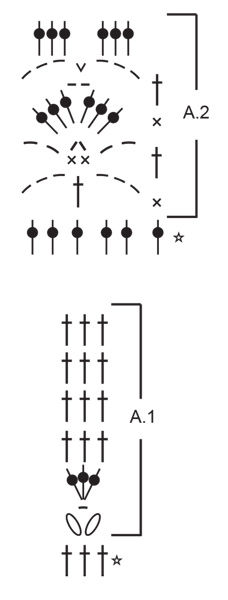
|
||||||||||||||||||||||
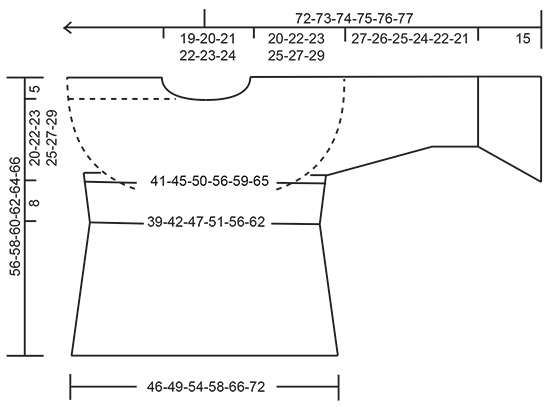
|
||||||||||||||||||||||
|
Have you made this or any other of our designs? Tag your pictures in social media with #dropsdesign so we can see them! Do you need help with this pattern?You'll find tutorial videos, a Comments/Questions area and more by visiting the pattern on garnstudio.com. © 1982-2024 DROPS Design A/S. We reserve all rights. This document, including all its sub-sections, has copyrights. Read more about what you can do with our patterns at the bottom of each pattern on our site. |
||||||||||||||||||||||







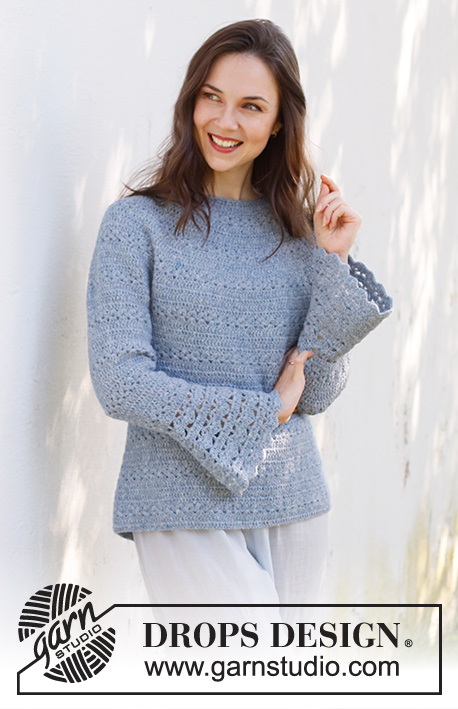
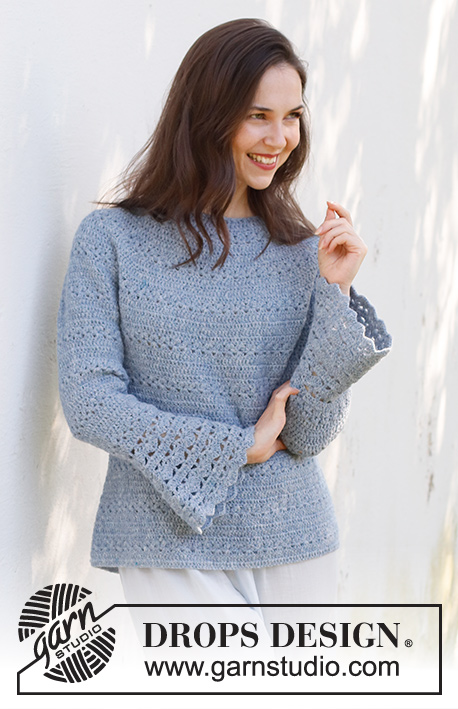


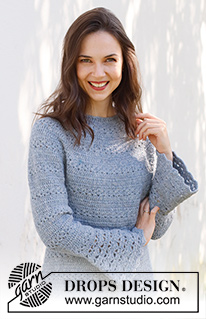
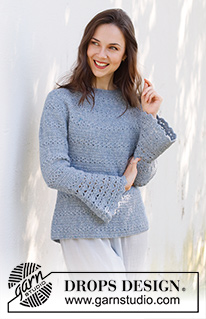
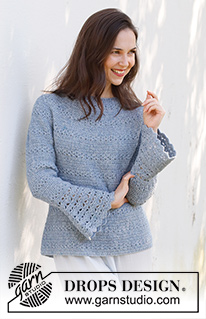
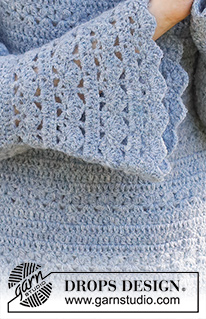












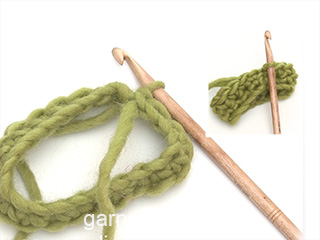



















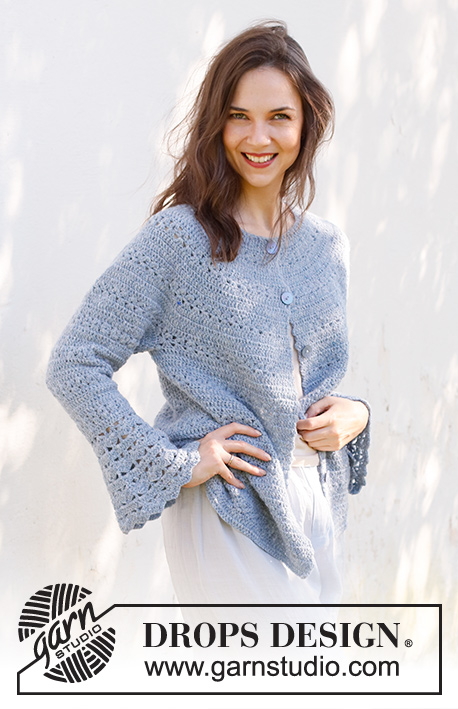







Comments / Questions (20)
Jeg kan simpelthen ikke forstå første og anden række i diagram A1. Kan i "skære det ud i pap" for mig?
16.01.2023 - 20:35How do I know how many things off yarn I need to get? The material list I'm not quite getting.
20.11.2022 - 23:18DROPS Design answered:
Dear Angel, you need to get those amounts of yarn of DROPS Sky. For example, for the smallest size you need 350gr of DROPS Sky. Each ball of Sky weighs 50 gr, so you need 350/50 = 7 balls of DROPS Sky for the smallest size. The other amounts indicated are for the other sizes (350-M, 400-L, 450-XL and XXL and 500-XXXL) and are calculated in the same way. Happy crocheting!
21.11.2022 - 01:06Hello, is main stitch here for example in the gauge and A1 treble or double crochet? Some days pattern says treble but some days I come back to the website for the pattern and it say double crochet. Thank you!
19.11.2022 - 14:02DROPS Design answered:
Dear Maya, you work in treble crochet (UK version)/ double crochet (US version). Each version has different terms for the same stitches, so you should check which version you are working, the US or UK English versions, so as to not get confused. Happy crocheting!
21.11.2022 - 00:41Ich finde die Anleitung sehr gut, nur hätte ich mir das Diagramm 1 klarer und mit mehr als 1 Mustersatz Wiederholung gewünscht. So sowie es jetzt ist , ist nicht klar das zwischen den einzelnen 2 Stäbchen , die zusammen abgemascht werden und mit der Luftmasche in der Mitte 3 Maschen bilden, man in der vorherigen Reihe 3 Maschen überspringen muss, ansonsten nimmt in jeder dieser ersten Runden von A1 zu!.
22.08.2022 - 16:51In the beginning of the pattern, when you say to increase a double crochet on rows 3 and 5 of A1, do you mean to add stitches in between each A1 or add stitches to A1?
20.07.2022 - 00:35DROPS Design answered:
Dear Lori, you increase over the double crochets from A.1, not in between the A.1 repeats. You can see the increasing tip for how to spread the increases across the row. Happy crocheting!
20.07.2022 - 17:20Beste Drops, bij informatie voor het haken staat: Op het begin van elke toer van stokjes, haakt u 3 lossen welke het eerste stokje niet vervangt. Eindig de toer met 1 halve vaste in de 3e losse op het begin van de toer. Als de eerste 3 lossen NIET als steek tellen maar ik daarin wel de toer moet eindigen, zal ik telkens een steek meerderen. Is dat de bedoeling? Ik hoor het graag.
15.06.2022 - 09:49DROPS Design answered:
Dag Anna,
Aan het eind van de toer, wanneer je de toer sluit met een halve vaste in de derde losse van de drie lossen, keer je het werk en haak je weer 3 lossen. Daarna haak je drie lossen boven de drie lossen van de vorige toer en vervolgens haak je de eerste steek volgens patroon in de laatst gehaakte steek van de vorige toer. Dit doe je elke toer. De 3 lossen die je telkens haakt zijn dus aanvullend op het patroon, maar je meerdert hierdoor geen steken.
26.06.2022 - 12:16Aw. Just Beautiful!
17.02.2022 - 14:17Crochet Blue
17.01.2022 - 22:32This truly is beyond stunning 😍 AND ITS CROCHETED 🧶 YEAH !!!!! HOW LUCKY 🍀 ARE WE. I can not begin to thank you for such lovely designs this season. You are all THE BEST 💖
17.01.2022 - 14:04Sporty Coquette
14.01.2022 - 14:26